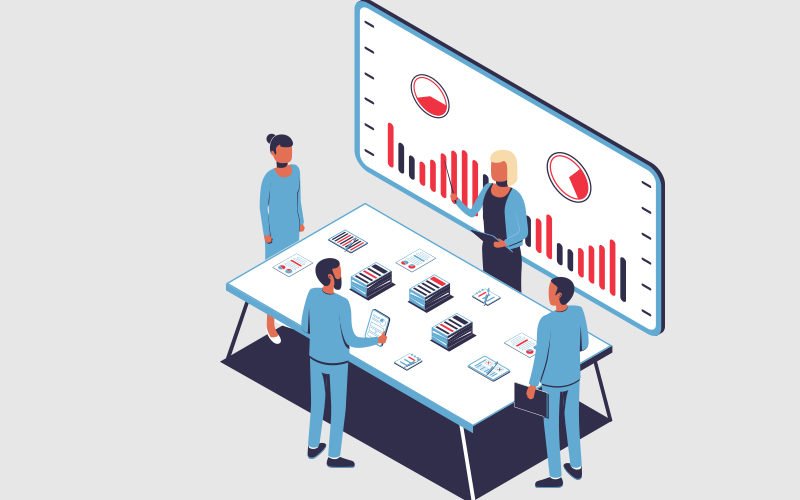Retail, CPG and Logistics
Why Big Data and Analytics Is a Must for Profitable Growth in CPG
In an increasingly competitive CPG marketplace, business leaders are often confronted by a few questions regularly:
- Which products will be next in line?
- What is the purchasing capacity of the top customers?
- What discounts will resonate with online visitors and when?
- Which marketing channel is best suited to gain more customers?
Today, an incredible amount of data is generated by the Consumer Packaged Goods (CPG) industry. This data assists business leaders in understanding the market better and take decisions that can improve the brand value and increase sales.
In addition, businesses also have access to massive data sets and information from social networks that can be collectively clubbed under big data. Adequately investing, organising, and analysing data is crucial for CPG businesses to gain actionable insights, as well as generate profits from retail and supply chain processes.
In a volatile global market, big data and advanced analytics can anticipate changing trends in the CPG sector and develop a progressive approach to spearhead profitable growth. In fact, management consulting major McKinsey reports that CPG businesses proficient in revenue-growth management (RGM) and data analytics tend to win and stay ahead of the pack.
How can advanced analytics be used in CPG businesses?
-
Predictive analytics:
CPG businesses can take full advantage of predictive analytics to map customers’ shopping experience and tweak their marketing strategies accordingly. Such data enables businesses to experiment with various strategies and to ascertain the market beforehand and influence customer purchases. -
Price and promotional analytics:
Price and promotional analytics provides insights on factors that drive and deliver profits at different levels of customer base, brands, and markets. It enables the creation of optimum prices by understanding the customers’ behaviour in relation to price changes.Evaluating customer behaviour through social media interactions is another method to strategise promotional and marketing solutions. Businesses can then capitalise on growth opportunities and link marketing and sales in a dynamic and holistic way.
-
Assortment optimisation analytics (market basket analysis):
Market basket analysis is one of the most common and useful types of data analysis for marketing and retailing. The purpose is to determine what types of products customers purchase together.The approach is based on the theory that customers who buy a particular item (or a group of items) are more likely to buy another specific item. This analysis defines the most essential, useful, and satisfying combinations of products to fashion optimal assortment of offerings for customer delight and to boost sales.
Types of data for decision making in CPG
In CPG data analytics, there are three types of data that brands can benefit from:
-
Observational data:
This data analyses the in-store position of the company’s products. It displays the results of a company’s implementation plan as well as product performance, along with an overview of upcoming opportunities in the market. -
Activity data:
This type of data showcases the specific measures taken by the business to improve product sales. Meaningful insights from this data can be implemented to ramp up sales and promotional activities. -
Sales data:
Sales data represents how many units of a product (SKU) are sold at a given point of time across specific or all locations. This data, when combined with the observational and activity data, paints a better picture of what decisions, activities, and executions lead to the highest sales.
Benefits of big data and advanced CPG analytics
CPG businesses that adopt big data and advanced analytics in their operations can apply it for product development, portfolio strategy, customer behaviour, and more. Here are some of the major benefits from big data and analytics to CPG businesses.
-
Simplified supply chain management
Data analytics streamlines complex supply chain operations and structures, enabling a smooth flow of information, eliminating unnecessary links, improving efficiency, and reducing expenditures. Big data and analytics can deliver a huge difference in providing businesses with a hands-on look at their supply chain, starting from the planning stage to sourcing, manufacturing, warehousing, transportation, and point of sale.The efficiency and accuracy of data and CPG analytics can transform the performance of supply chains and yield better results.
-
Focused inventory management
Another benefit for CPG businesses is how data assists in accurately planning, forecasting, and optimising inventory to save space, money, and resources, especially when it comes to unfulfilled inventory.Data consolidation facilitates effective inventory management across locations and divisions around the world, thereby reducing costs and overage, as well as improving focus on profitable items.
-
Value-driven marketing efforts
Marketing a product is always tied to the current customers’ preferences. Predictive data and analytics, from sources like social media, company websites, and user registrations, determines the effectiveness of each communication channel, assesses viability, tracks various key performance indicators (KPIs), and develops insights into the customers' shopping behaviour.Data and analytics also reveals information about the customers’ buying inclinations, preferences, and emotions, thereby improving marketing strategy and effective spend. An intensive data and analytics infrastructure can boost ROIs and complement the marketing effort.
-
Effective consumer personalisation
Today, there is ample information on buying and spending trends of customers. CPG marketers need to harness this customer data for personalisation. They must possess a holistic understanding of how customers use and access marketing information and how that translates into buying behaviours, product impressions, and sales.This knowledge will let marketers connect with customers with current, relevant, and tailored messages. Thus, advancement in technology, data, and analytics allows marketers to create much more personal and “human” experiences across channels and buying stages.
-
Increased agility
With data and analytics, CPG businesses can anticipate and respond to shifting buyer demographics and withstand rapid changes in the market. Data takes the guesswork out of decision making, and leaders who drive strategy can focus on deriving meaningful insights from data. This also enables businesses to act quickly and develop strategies for better business outcomes.
Conclusion
The mileage and profits created by investing in CPG data analytics are exponential. Businesses need to invest heavily on big data and advanced analytics to improve their bottom line. With these two components, businesses can focus on delivering impactful services to customers.
In the short term, tracking CPG data insights provides accurate description of the ongoing operations in multiple retail locations. As a long-term strategy, measuring and tracking this data can empower businesses to make more informed decisions to allocate resources better and ensure that supply chain processes and solutions are delivering the highest possible results.






